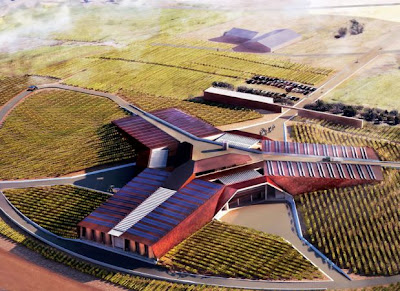Like I said in my previous post, it does occasionally rain in northern Spain. So when the forecast predicted not so nice weather in Santander, we decided to leave our friends for a few days to travel south to the area of La Rioja. Sometime last year I had read an article in Easyjet's inflight magazine (of all places..) about the amazing architecture of some of the wineries in that region. I had kept a copy and with its help we mapped out a route for our little road trip.
After spending the night in a charming posada in the (extremely) sleepy village of Sajazarra (there was not even a shop in this village, but at 8.30 am a man drove through the village blaring through a megaphone that he was selling melons from his trunk) we had our first tour and wine tasting at 10 am at Bodegas López de Heredia Viña Tondonia. Architecturally not the most exciting winery (only the reception slash tasting room has a futuristic, decanter-shaped design), but our friends (and Easyjet) recommended the place because it's one of the oldest wineries in the region and they still make wine the traditional way.
I'm glad we made this our first stop, because we learned a lot about the process of wine making and the natural conditions that influence it (temperature, the wood and age of the barrels, humidity, mold and spiders). I was very impressed (and at the same time disgusted) by all the mold that covers the walls. It works as a form of insulation that keeps the temperature and humidity in check.
They make some unique white wines, that are well worth a taste. Best thing is the tour will cost you €10, but when you buy a bottle they'll give you a €10 discount on showing them your ticket. So we left, after being entertained and educated for an hour and a half, had two free glasses of wine, with two bottles of wine that had cost us €2,50!
After about a half an hour drive we reached Marqués de Riscal in the village of Elciego, in the Basque country. It is well known for the building designed by Frank Gehry (opened in 2006). The colors reflect the colors of the wine and bottles (silver and gold). The story goes Gehry was apprehensive at first, but was convinced to work for them after they had opened a bottle from the year he was born, 1929.
∧ I couldn't even get a decent photo of the whole building because they were cleaning the titanium (!) plates with a cherry picker :-(
Gehry's building is a hotel, restaurant, bistro and spa. Unless you're staying at this luxury hotel or have a (Michelin starred) meal or have a vinotherapy (pfff!) here you can't get nearer than where I took my picture. The winery itself is housed in far less interesting buildings and is much more like a factory really, with massive halls filled with massive stainless steel tanks.
By inviting Gehry they hoped the building would do for the winery what the Guggenheim did for Bilbao. And I think it has worked... The places was heaving. There were about 30 people on the tour, which started by showing us an awful corporate film. In all the whole experience was a bit of a disappointment. But I would love to go back and have their tasting menu in the more affordable bistro, to get a closer look at the building, and to sample their chickpea stew with monkfish and clams and meat balls with truffle.
By inviting Gehry they hoped the building would do for the winery what the Guggenheim did for Bilbao. And I think it has worked... The places was heaving. There were about 30 people on the tour, which started by showing us an awful corporate film. In all the whole experience was a bit of a disappointment. But I would love to go back and have their tasting menu in the more affordable bistro, to get a closer look at the building, and to sample their chickpea stew with monkfish and clams and meat balls with truffle.
That afternoon we continued our roadtrip by driving in a south-western direction towards the region of Ribera del Duero. It was a long but beautiful drive that took us through green hills, rocky canyons, passing clear blue lakes and over vast planes. The next day we had booked a tour and tasting at Bodega Portia. Their brand new building (2010) has been designed by the British architect Norman Foster (also know for 'The Gherkin' in London).
Now this was truly an impressive design, where the building has been fully integrated with process of the wine making and the rest of the corporate design. The building is a three-legged star, and in each of the wings one stage of the wine making process takes place: vinification, fermentation and aging. When the grapes have been harvested the trucks drive up the slope to the top of the building where they off load the grapes by dumping them onto a corkscrew sort of devise that transports the grapes to a lower level without them being crushed. Amazing! Inside the small windows (which are at ground level) provide a wine colored glow. There's also a restaurant with a beautiful outside seating area where you can have lunch or just a coffee.
There are many more wineries with impressive architecture in La Rioja and surrounding areas and I'd love to go back and visit some more. It's just such a tasteful combination.









No comments:
Post a Comment